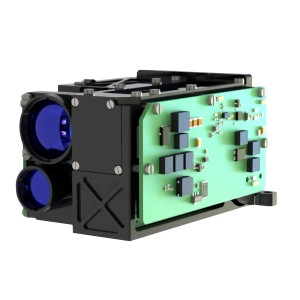Laser Ranging Target Designator 25mJ
TECHNICAL SPECIFICATIONS
|
project |
Indicator data |
Comment entry |
|
central wavelength |
1064nm |
1 |
|
Ranging capability |
≥5000m |
2 |
|
Ranging blind area |
≤100m |
3 |
|
Ranging accuracy |
≤±2m |
4 |
|
working frequency |
Single、1Hz、5Hz、20Hz |
5 |
|
product weight |
≤440g |
6 |
|
Dimensions |
≤91mm×68mm×51.5mm |
7 |
|
voltage |
18V~32V |
8 |
|
environmental adaptability |
Operating temperature:-40℃~60℃ Storage temperature:-55℃~70℃ |
9 |
|
average energy |
≥25mJ |
10 |
|
energy stability |
≤8%(Statistics after 2 seconds of light emission) |
11 |
|
Divergence angle |
≤0.5mrad |
12 |
|
pulse width |
15±5ns |
13 |
|
Irradiation distance |
≥2500m(Reference) |
14 |
|
Encoding |
Precise frequency encoding, external synchronization |
15 |
|
Coding accuracy |
≤±2.5μs |
16 |
1. Working band
The central wavelength of the laser when the LDR25 is working is 1064nm. It is forbidden to look directly at the laser of the light detector when it is working to avoid unnecessary personal injury.
2. Ranging capability
In an environment with visibility ≥ 8Km and humidity ≤ 60%, when testing a target plate (or other equivalent target) with a reflectance of 0.3 in size 2.3m×2.3m, the distance measuring capability of the laser photometer can reach more than 5000m, and The accuracy rate is greater than 98%, which is also a key indicator for judging whether the laser detector is qualified. the relationship between laser range and visibility under theoretical conditions.
Factors such as target reflectivity and measurement angle will affect the ranging capability. Generally, the higher the target reflectivity, the better the ranging ability; the more vertical the laser angle is when it irradiates the measurement target reflective surface, the better the ranging ability. In practical applications, the laser of the illumination detector should be irradiated vertically to the target surface as much as possible. For targets with medium and high reflectivity, such as traffic signs and other targets, the performance of the illumination detector can also be better.
3. Ranging blind area
For targets within 100m, the laser photometer may not be able to accurately measure, which is its ranging blind spot. It is not recommended that users test targets in the blind area of the illumination detector because the echo of the illumination detector to targets in the blind area is strong, which may result in reduced detector life or ranging capabilities, especially for targets in the blind area. High reflectivity target testing may even cause permanent damage to the detector. Therefore, when the photometer is under close working conditions such as debugging, please block the receiving lens.
4. Distance measurement accuracy
For targets with an accuracy rate of ≥98%, the accuracy error of the laser photometer can reach within 2m. For example, for a target with an actual distance of 1000m, the maximum range of the measurement value of the laser photometer will be within 998m and 1002m.
5. Working frequency
The laser photometer can achieve single, 1Hz, 5Hz ranging and 20Hz irradiation by sending different instructions. For the corresponding instructions and operation instructions, see 3 Functions and Operations.
6. Weight
The total weight of the laser photometer is ≤440g.
7. Overall dimensions
91mm×68mm×51.5mm is the maximum size of the laser photometer.
8. Power supply voltage
The power supply voltage of the photometer ranges from 18V to 32V.
9. Environmental adaptability
The photometer can operate normally under the conditions of -40℃~60℃, and the storage temperature range is -55℃~70℃. It is recommended to work or store the photometer in a normal temperature and dry environment. Too high or too low temperature may cause the decline of certain indicators of the photometer. In particular, avoid using the photometer in an environment with drastic changes in temperature. , which may reduce the life of the photometer or cause malfunction.
10. Average energy
The average energy irradiated by the laser photometer is ≥25mJ.
11. Energy stability
Within one cycle, the fluctuation of adjacent pulses is ≤8% (statistics after 2 seconds of light emission).
12. Divergence angle
The laser beam divergence angle of the laser photometer is ≤0.5mrad.
13. Pulse width
The light pulse width of the laser photometer is 15±5ns.
14. Irradiation distance
When the laser photometer executes the irradiation instruction, the longest distance it can irradiate is ≥ 2500m (reference value).
15. Coding method
The laser photometer has user-defined coding expansion capabilities; the coding method of the laser photometer is precise frequency coding and external synchronization; the coding setting is 8 fixed codes + 8 expansion codes (the fixed code cannot be changed after being customized by the user, and the expansion code Users can set it by themselves, but it should not exceed 22Hz).
16. Coding accuracy
The coding accuracy of the laser photometer is ≤±2.5μs.







